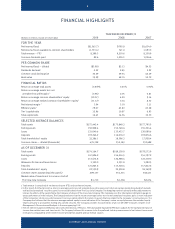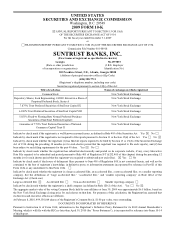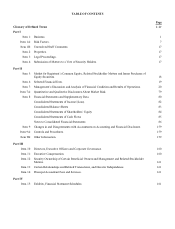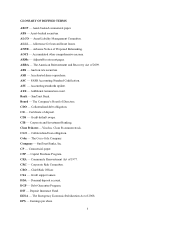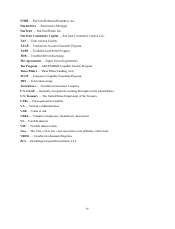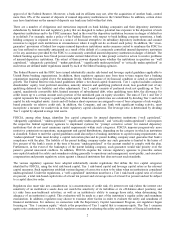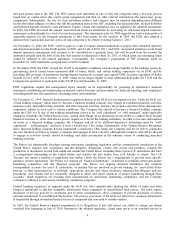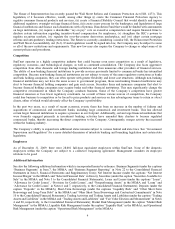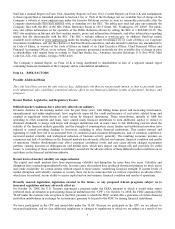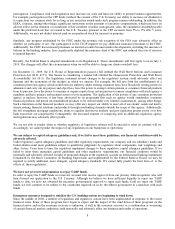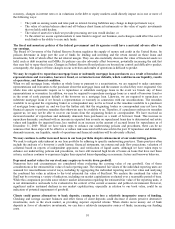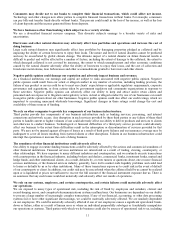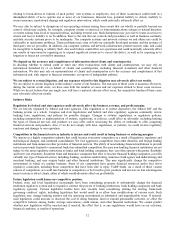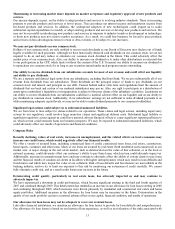SunTrust 2009 Annual Report Download - page 20
Download and view the complete annual report
Please find page 20 of the 2009 SunTrust annual report below. You can navigate through the pages in the report by either clicking on the pages listed below, or by using the keyword search tool below to find specific information within the annual report.that pose greater risks to the DIF. The FDIC places each institution in one of four risk categories using a two-step process
based first on capital ratios (the capital group assignment) and then on other relevant information (the supervisory group
assignment). Subsequently, the rate for each institution within a risk category may be adjusted depending upon different
factors that either enhance or reduce the risk the institution poses to the DIF, including the unsecured debt, secured liabilities
and brokered deposits related to each institution. Finally, certain risk multipliers may be applied to the adjusted assessment.
In 2009, the FDIC increased the amount assessed from financial institutions by increasing its risk-based deposit insurance
assessment scale uniformly by a total of seven basis points. The assessment scale for 2009 ranged from twelve basis points of
assessable deposits for the strongest institutions to fifty basis points for the weakest. In 2009, the FDIC also adopted a
uniform three basis points increase across all risk categories to be effective starting January 1, 2011.
On November 12, 2009, the FDIC voted to approve a rule to require insured institutions to prepay their estimated quarterly
risk-based assessments for the fourth quarter of 2009, and for all of 2010, 2011, and 2012. An insured institution’s risk-based
deposit insurance assessments will continue to be calculated on a quarterly basis, but will be paid from the amount the
institution prepaid until the later of the date that amount is exhausted or June 30, 2013, at which point any remaining funds
would be returned to the insured institution. Consequently, the Company’s prepayment of DIF premiums made on
December 29, 2009 resulted in a prepaid asset of $924.8 million.
In November 2008, the FDIC created the TLGP to strengthen confidence and encourage liquidity in the banking system by
guaranteeing newly issued senior unsecured debt of banks, thrifts, and certain holding companies via its DGP, and by
providing full coverage of noninterest bearing deposit transaction accounts and capped NOW accounts, regardless of dollar
amount via its TAGP. As of October 31, 2009, banks are no longer eligible to issue additional debt under the TLGP and the
Company has opted not to participate in the TAGP beyond December 31, 2009.
FDIC regulations require that management report annually on its responsibility for preparing its institution’s financial
statements, establishing and maintaining an internal control structure and procedures for financial reporting, and compliance
with designated laws and regulations concerning safety and soundness.
On November 12, 1999, financial modernization legislation known as the GLB Act was signed into law. Under the GLB Act,
a bank holding company which elects to become a financial holding company may engage in expanded securities activities,
insurance sales, and underwriting activities, and other financial activities, and may also acquire securities firms and insurance
companies, subject in each case to certain conditions. The Company has elected to become a financial holding company
under the GLB Act. If any of our banking subsidiaries ceases to be “well capitalized” or “well managed” under applicable
regulatory standards, the Federal Reserve may, among other things, place limitations on our ability to conduct these broader
financial activities or, if the deficiencies persist, require us to divest the banking subsidiary. In order to become and maintain
its status as a financial holding company, the Company and all of its affiliated depository institutions must be “well-
capitalized,” “well-managed,” and have at least a satisfactory CRA rating. Furthermore, if the Federal Reserve determines
that a financial holding company has not maintained a satisfactory CRA rating, the Company will not be able to commence
any new financial activities or acquire a company that engages in such activities, although the Company will still be allowed
to engage in activities closely related to banking and make investments in the ordinary course of conducting merchant
banking activities.
The Patriot Act substantially broadens existing anti-money laundering legislation and the extraterritorial jurisdiction of the
United States; imposes new compliance and due diligence obligations; creates new crimes and penalties; compels the
production of documents located both inside and outside the United States, including those of non-U.S. institutions that have
a correspondent relationship in the United States; and clarifies the safe harbor from civil liability to clients. The U.S.
Treasury has issued a number of regulations that further clarify the Patriot Act’s requirements or provide more specific
guidance on their application. The Patriot Act requires all “financial institutions,” as defined, to establish certain anti-money
laundering compliance and due diligence programs. The Patriot Act requires financial institutions that maintain
correspondent accounts for non-U.S. institutions, or persons that are involved in private banking for “non-United States
persons” or their representatives, to establish, “appropriate, specific and, where necessary, enhanced due diligence policies,
procedures, and controls that are reasonably designed to detect and report instances of money laundering through those
accounts.” Bank regulators are focusing their examinations on anti-money laundering compliance, and the Company
continues to enhance its anti-money laundering compliance programs.
Federal banking regulators, as required under the GLB Act, have adopted rules limiting the ability of banks and other
financial institutions to disclose nonpublic information about consumers to nonaffiliated third parties. The rules require
disclosure of privacy policies to consumers and, in some circumstances, allow consumers to prevent disclosure of certain
personal information to nonaffiliated third parties. The privacy provisions of the GLB Act affect how consumer information
is transmitted through diversified financial services companies and conveyed to outside vendors.
In 2009, the Federal Reserve adopted amendments to its Regulation E that will restrict our ability to charge our clients
overdraft fees beginning in July of 2010. Pursuant to the adopted regulation, clients must opt-in to an overdraft service in
4


